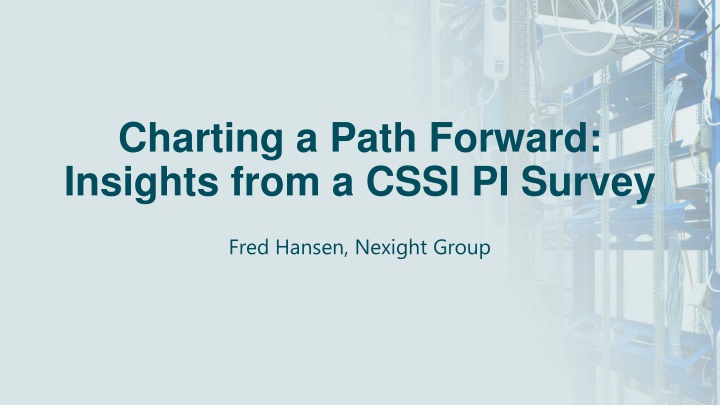
Insights from CSSI PI Survey on NSF Cyberinfrastructure Changes
Gain valuable insights from a CSSI PI survey regarding necessary changes to the National Science Foundation's Cyberinfrastructure for Sustained Scientific Innovation (CSSI) solicitation and umbrella program. Learn about survey purposes, design, respondent demographics, and identified areas for solicitation improvements based on feedback from 251 respondents.
Download Presentation

Please find below an Image/Link to download the presentation.
The content on the website is provided AS IS for your information and personal use only. It may not be sold, licensed, or shared on other websites without obtaining consent from the author. If you encounter any issues during the download, it is possible that the publisher has removed the file from their server.
You are allowed to download the files provided on this website for personal or commercial use, subject to the condition that they are used lawfully. All files are the property of their respective owners.
The content on the website is provided AS IS for your information and personal use only. It may not be sold, licensed, or shared on other websites without obtaining consent from the author.
E N D
Presentation Transcript
Charting a Path Forward: Insights from a CSSI PI Survey Fred Hansen, Nexight Group
Survey Purpose & Design Two primary purposes for the survey: Inform decisions about changes to be made to the National Science Foundation (NSF) Cyberinfrastructure for Sustained Scientific Innovation (CSSI) solicitation. Inform decisions about the future direction and focus of the NSF CSSI umbrella program. Three phases of design: Determine the nature of the decisions to be made Determine the information needed to inform the decisions (Who needs to say what about what?) Write survey items
Survey Purpose & Design Decision makers used a two-stage decision-making process:
Survey Purpose & Design Survey design parameters: PI input is critical and valued CSSI wants to maximize PI ability to write effective proposals CSSI seeks to engage the passion and creativity of PIs as well as their expertise and capability PI time is valuable Minimize time required to complete survey Only questions that directly tied to the decisions were included in the survey Questions that were of interest to the decision makers but not directly tied to a decision were excluded
Survey Respondents 251 respondents: 97% were PIs or co-PIs 55% had served as a proposal reviewer in the past year 98% had previously submitted a proposal to NSF, 73% of whom received funding 90% listed universities as their primary organization Respondents were representative of the target population and comparable to the respondents of other NSF surveys.
Need for Change Solicitation The survey results clearly identify four aspects of the solicitation where change is needed and would make the most difference: Types of awards the two classes of CSSI awards and the size, duration, and timing of the funding associated with each type. Combined software/data umbrella the inclusion of both software and data perspectives under a single umbrella scope Presentation of domain-specific interests the number of areas, the clarity of the descriptions, and the level of specificity and amount of detail provided Solicitation-specific criteria the appropriateness and number of additional solicitation- specific review criteria and the clarity and detail with which they are described
How to Change Solicitation Types of awards: All change options were selected by a significant portion of respondents. The top two were: Add an award category for exploratory research Distinguish between data and software awards Combined software/data umbrella: The top change option selected: Create separate software and data solicitations Respondents also selected: Require more integration across data and software services Require collaboration across data and software developers
How to Change Solicitation Presentation of domain-specific interests: Respondents advocated for increasing clarity and simplicity in the presentation of domain-specific interests: Eliminate the redundancy across the domain specific interests Focus on smaller numbers of topics in each solicitation Decrease the number and complexity of the domain-specific interest areas Solicitation-specific criteria: Respondents are advocating for more help on how to meet the criteria: Provide more guidance on how to meet the criteria Identify best practices to be incorporated into a proposal
Need for Change CSSI Direction & Focus The need for change was assessed from three perspectives: 1. Relevance of program assumptions for the next 1 5 years 2. CSSI success in achieving its objectives 3. CSSI success in implementing its guiding principles
Need for Change CSSI Direction & Focus 1. Program Assumptions (1 5 years): There was a high level of agreement for each of the three assumptions. NSF CSSI Program Assumptions: This indicates that therationale for the CSSI Program is still valid and there is no need for change in terms of the overall direction and focus of the program.
Need for Change CSSI Direction & Focus 2. Success in Meeting Objectives: NSF CSSI Program Objectives: Some need for change was indicated: The majority of respondents indicated that the CSSI program has been successful in achieving each of the four objectives Success in supporting the development of CI rated higher than deployment of CI Slightly lower ratings also given for supporting CI capabilities, data, and software that enable scientific innovation and discovery
Need for Change CSSI Direction & Focus 3. Success in Implementing Guiding Principles: NSF CSSI Program Guiding Principles: Some need for change was indicated: The majority of respondents indicated that the CSSI program has been successful in implementing all guiding principles, except for Sustained The most success was indicated in meeting the Science-Driven and Innovative principles
How to Change CSSI Direction & Focus This area was assessed by having respondents indicate what they think CSSI s investment priorities should be for the next 1 5 years. Based on a thematic analysis, the rank order for the top investment priorities was: Data Software Learning/Workforce Development Networking AI/Machine Learning Security/Resilience Collaborations Additional investment priorities identified by respondents included: Simulation/Modeling Metrics (to assess CI impact and effectiveness) CI Community Development Domain-specific CI Investment (e.g., CI for Chemistry, Physics, Sociology)






















